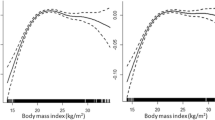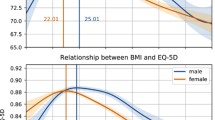Abstract
Purpose
To examine the prospective associations between body mass index (BMI) and health-related quality of life (HRQoL).
Methods
Data were extracted from a longitudinal, nationally representative sample of 9916 men and women aged 18 years and over who were followed annually between 2006 and 2016 in the Household, Income and Labour Dynamics in Australia (HILDA) survey. HRQoL was assessed using the self-administered SF-36 questionnaire annually between 2006 (baseline) and 2016. BMI was calculated from self-reported height and weight and was classified into the following four categories of baseline BMI: underweight (< 18.5 kg/m2), normal weight (18.5–24.9 kg/m2), overweight (25–29.9 kg/m2) and obese (≥ 30 kg/m2). We used linear mixed-effects regression models to investigate the associations between change in BMI (kg/m2) and concurrent changes in HRQoL scores over 11 years.
Results
BMI gain was associated with deterioration of Physical Component Summary (PCS) (P < 0.001), but not with change in Mental component summary (MCS) over the 11-year period. BMI gain was inversely associated (P < 0.001) with five of the eight HRQoL domains (physical functioning, role physical, bodily pain, general health and vitality) with a significant graded association according to baseline BMI category. Over the 11-year study period, every unit increase in PCS was associated with a decrease of 0.02 (P < 0.001), 0.03 (P < 0.001) and 0.04 (P < 0.001) BMI units per year among participants who were normal, overweight and obese at baseline, respectively. Five of the eight domains of HRQoL (physical functioning, role physical, bodily pain, general health and vitality) were inversely associated with BMI (P < 0.001) with a significant graded association according to baseline BMI category.
Conclusions
Weight gain was not only associated with deterioration of HRQoL, and vice versa. The bi-directional association was stronger for physical than mental domains of HRQoL.
Similar content being viewed by others
References
Renu, G. (2017). Health effects of overweight and obesity in 195 countries over 25 years. New England Journal of Medicine,377(1), 13–27.
Ezzati, M. (2017). Excess weight and multimorbidity: Putting people's health experience in risk factor epidemiology. The Lancet Public Health.,2(6), e252–e253.
Whitlock, G., Lewington, S., Sherliker, P., Clarke, R., Emberson, J., Halsey, J., et al. (2009). Body-mass index and cause-specific mortality in 900 000 adults: Collaborative analyses of 57 prospective studies. Lancet (London, England),373(9669), 1083–1096.
Di Angelantonio, E., Bhupathiraju, S. N., Wormser, D., Gao, P., Kaptoge, S., de Gonzalez, A. B., et al. (2016). Body-mass index and all-cause mortality: Individual-participant-data meta-analysis of 239 prospective studies in four continents. The Lancet,388(10046), 776–786.
Fuller-Thomson, E., Howden, K. E. N., Fuller-Thomson, L. R., & Agbeyaka, S. (2018). A strong graded relationship between level of obesity and COPD: Findings from a National Population-Based Study of Lifelong Nonsmokers. Journal of Obesity,2018, 9.
Behrens, G., Matthews, C. E., Moore, S. C., Hollenbeck, A. R., & Leitzmann, M. F. (2014). Body size and physical activity in relation to incidence of chronic obstructive pulmonary disease. CMAJ: Canadian Medical Association Journal,186(12), E457–E469.
Dudina, A., Cooney, M. T., Bacquer, D. D., Backer, G. D., Ducimetiere, P., Jousilahti, P., et al. (2011). Relationships between body mass index, cardiovascular mortality, and risk factors: A report from the SCORE investigators. European Journal of Cardiovascular Prevention and Rehabilitation: Official Journal of the European Society of Cardiology, Working Groups on Epidemiology & Prevention and Cardiac Rehabilitation and Exercise Physiology,18(5), 731–742.
Colagiuri, S., Lee, C. M., Colagiuri, R., Magliano, D., Shaw, J. E., Zimmet, P. Z., et al. (2010). The cost of overweight and obesity in Australia. The Medical Journal of Australia,192(5), 260–264.
Jackson, C. A., Sudlow, C. L. M., & Mishra, G. D. (2018). Psychological distress and risk of myocardial infarction and stroke in the 45 and up study. Circulation: Cardiovascular Quality and Outcomes,11(9), 45.
Lehnert, T., Sonntag, D., Konnopka, A., Riedel-Heller, S., & König, H.-H. (2013). Economic costs of overweight and obesity. Best Practice & Research Clinical Endocrinology & Metabolism,27(2), 105–115.
Muller-Nordhorn, J., Muckelbauer, R., Englert, H., Grittner, U., Berger, H., Sonntag, F., et al. (2014). Longitudinal association between body mass index and health-related quality of life. PLoS ONE,9(3), e93071.
Bottone, F. G., Hawkins, K., Musich, S., Cheng, Y., Ozminkowski, R. J., Migliori, R. J., et al. (2013). The relationship between body mass index and quality of life in community-living older adults living in the United States. The Journal of Nutrition, Health & Aging,17(6), 495–501.
Cameron, A. J., Magliano, D. J., Dunstan, D. W., Zimmet, P. Z., Hesketh, K., Peeters, A., et al. (2011). A bi-directional relationship between obesity and health-related quality of life: Evidence from the longitudinal AusDiab study. International Journal of Obesity,36, 295.
Jia, H., & Lubetkin, E. I. (2005). The impact of obesity on health-related quality-of-life in the general adult US population. Journal of public health (Oxford, England),27(2), 156–164.
Williams, J. W., Canterford, L., Hesketh, K. D., Hardy, P., Waters, E. B., Patton, G. C., et al. (2011). Changes in body mass index and health related quality of life from childhood to adolescence. International Journal of Pediatric Obesity: IJPO: An Official Journal of the International Association for the Study of Obesity,6(2–2), e442–e448.
Hebestreit, H., Schmid, K., Kieser, S., Junge, S., Ballmann, M., Roth, K., et al. (2014). Quality of life is associated with physical activity and fitness in cystic fibrosis. BMC Pulmonary Medicine,14(1), 26.
Kivimäki, M., Lawlor, D. A., Singh-Manoux, A., Batty, G. D., Ferrie, J. E., Shipley, M. J., et al. (2009). Common mental disorder and obesity: Insight from four repeat measures over 19 years: Prospective Whitehall II cohort study. BMJ,339, b3765.
Tucker, L. A., & Earl, A. B. (2010). Emotional health and weight gain: A prospective study of midlife women. American Journal of Health Promotion: AJHP,25(1), 30–35.
2013 WHOMhapGWHO.
Renu, H. (1995). Position paper from the World Health Organization. Social Science & Medicine,41(10), 1403–1439.
Watson N. Longitudinal and cross-sectional weighting methodology for the HILDA survey, HILDA project technical paper series no. Retrieved from Melbourne, Australia: 2/12. Melbourne: Melbourne Institute; 2012.
Ezzati, M. (2017). Excess weight and multimorbidity: Putting people's health experience in risk factor epidemiology. The Lancet Public Health,2(6), e252–e253.
Stewart, M. (2007). The Medical Outcomes Study 36-item short-form health survey (SF-36). The Australian Journal of Physiotherapy,53(3), 208.
Hooker, S. A. (2013). SF-36. In M. D. Gellman & J. R. Turner (Eds.), Encyclopedia of behavioral medicine (pp. 1784–1786). New York: Springer.
Butterworth, P., & Crosier, T. (2004). The validity of the SF-36 in an Australian National Household Survey: Demonstrating the applicability of the Household Income and Labour Dynamics in Australia (HILDA) Survey to examination of health inequalities. BMC Public Health,4, 44.
Kamp Dush, C. M., Yavorsky, J. E., & Schoppe-Sullivan, S. J. (2018). What are men doing while women perform extra unpaid labor? Leisure and specialization at the transition to parenthood. Sex Roles,78(11–12), 715–730.
Milton, K., Bull, F. C., & Bauman, A. (2011). Reliability and validity testing of a single-item physical activity measure. British Journal of Sports Medicine,45(3), 203–208.
Perales, F., Pozo-Cruz, J. D., & Pozo-Cruz, B. D. (2014). Impact of physical activity on psychological distress: A prospective analysis of an Australian National Sample. American Journal of Public Health.,104(12), e91–e97.
Kivimaki, M., Kuosma, E., Ferrie, J. E., Luukkonen, R., Nyberg, S. T., Alfredsson, L., et al. (2017). Overweight, obesity, and risk of cardiometabolic multimorbidity: Pooled analysis of individual-level data for 120 813 adults from 16 cohort studies from the USA and Europe. The Lancet Public Health,2(6), e277–e285.
Friel, S., Berry, H., Dinh, H., O’Brien, L., & Walls, H. L. (2014). The impact of drought on the association between food security and mental health in a nationally representative Australian sample. BMC Public Health,14(1), 1102.
Laxy, M., Teuner, C., Holle, R., & Kurz, C. (2017). The association between BMI and health-related quality of life in the US population: Sex, age and ethnicity matters. International Journal of Obesity,42, 318.
Doll, H. A., Petersen, S. E. K., & Stewart-Brown, S. L. (2000). Obesity and physical and emotional well-being: Associations between body mass index, chronic illness, and the physical and mental components of the SF-36 Questionnaire. Obesity Research,8(2), 160–170.
de Zwaan, M., Petersen, I., Kaerber, M., Burgmer, R., Nolting, B., Legenbauer, T., et al. (2009). Obesity and quality of life: A controlled study of normal-weight and obese individuals. Psychosomatics,50(5), 474–482.
Slagter, S. N., van Vliet-Ostaptchouk, J. V., van Beek, A. P., Keers, J. C., Lutgers, H. L., van der Klauw, M. M., et al. (2015). Health-related quality of life in relation to obesity Grade, Type 2 Diabetes, metabolic syndrome and inflammation. PLoS ONE,10(10), e0140599.
Wallander, J. L., Kerbawy, S., Toomey, S., Lowry, R., Elliott, M. N., Escobar-Chaves, S. L., et al. (2013). Is obesity associated with reduced health-related quality of life in Latino, Black and White children in the community? International Journal of Obesity,37(7), 920–925.
Biesma, R., & Hanson, M. (2016). Global, National, and Community Obesity Prevention Programs. In R. S. Ahima (Ed.), Metabolic syndrome: A comprehensive textbook (pp. 851–866). Cham: Springer.
Hurt, R. T., Kulisek, C., Buchanan, L. A., & McClave, S. A. (2010). The obesity epidemic: Challenges, health initiatives, and implications for gastroenterologists. Gastroenterology & Hepatology,6(12), 780–792.
Skidmore, P. M. L., & Yarnell, J. W. G. (2004). The obesity epidemic: Prospects for prevention. QJM: An International Journal of Medicine,97(12), 817–825.
Avila-Funes, J. A., Gutierrez-Robledo, L. M., & Ponce De Leon Rosales, S. (2004). Validity of height and weight self-report in Mexican adults: Results from the National Health and Aging Study. The Journal of Nutrition, Health & Aging,8(5), 355–361.
Luo, Y., Hawkley, L. C., Waite, L. J., & Cacioppo, J. T. (2012). Loneliness, health, and mortality in old age: A national longitudinal study. Social Science & Medicine.,74(6), 907–914.
Acknowledgements
We thank the National Centre for Longitudinal Data (NCLD) for allowing us to access the HILDA dataset. The HILDA project was initiated and is funded by the Australian Government Department of Families, Housing, Community Services and Indigenous Affairs (FaHCSIA) and is managed by the Melbourne Institute of Applied Economic and Social Research (Melbourne Institute).
Funding
The authors received no specific funding for this work.
Author information
Authors and Affiliations
Contributions
Study concept and design: BWS. Acquisition of data: BWS. Analysis and interpretation of data: BWS. Drafting the manuscript: BWS. Critical revision of the manuscript for important intellectual content: BWS, SS, YAM, LL and AMNR. BWS is the guarantor of this work and, as such, had full access to all of the data in the study and takes responsibility for the integrity of data and the accuracy of data analysis.
Corresponding author
Ethics declarations
Conflict of interest
The authors declare that they have no conflict of interest.
Additional information
Publisher's Note
Springer Nature remains neutral with regard to jurisdictional claims in published maps and institutional affiliations.
Electronic supplementary material
Below is the link to the electronic supplementary material.
Rights and permissions
About this article
Cite this article
Sahle, B.W., Slewa-Younan, S., Melaku, Y.A. et al. A bi-directional association between weight change and health-related quality of life: evidence from the 11-year follow-up of 9916 community-dwelling adults. Qual Life Res 29, 1697–1706 (2020). https://doi.org/10.1007/s11136-020-02423-7
Accepted:
Published:
Issue Date:
DOI: https://doi.org/10.1007/s11136-020-02423-7




